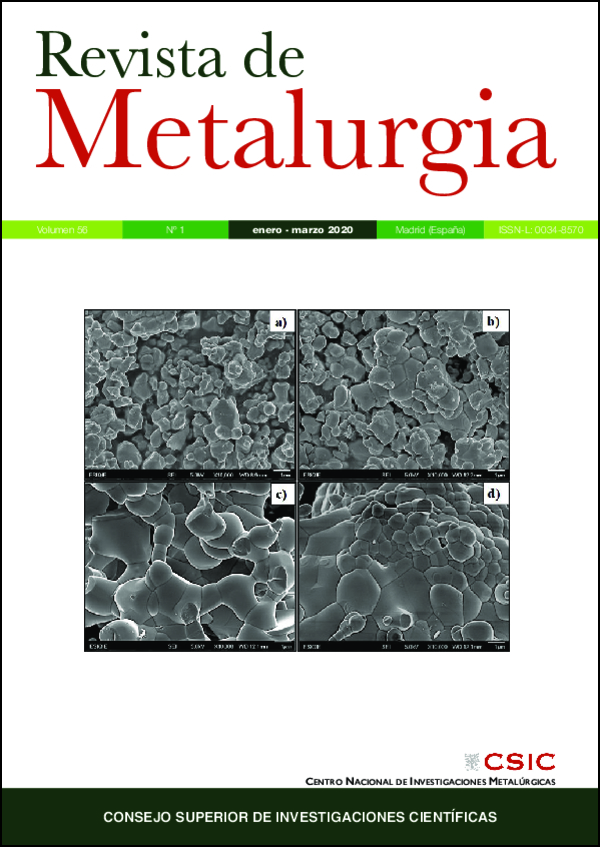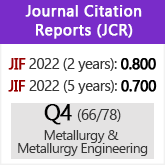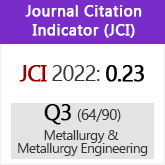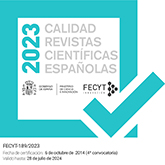Crystallization pressure and volume variation during rust development in marine and urban-continental environments: Critical factors influencing exfoliation
DOI:
https://doi.org/10.3989/revmetalm.164Keywords:
Carbon steel, Corrosion, Crystallization pressure, Rust exfoliation, Volume variation, XRDAbstract
The rust layer formed on carbon steel exposed to natural marine and urban-continental environments for up to 50 years was studied. Mineralogical phase composition of the rust layer was evaluated by X-ray diffraction (XRD), akaganeite, goethite, lepidocrocite, magnetite, and amorphous phases were identified. Morphological characterization of the specimens was performed using scanning electron microscopy (SEM), and energy-dispersive X-ray (EDX) microanalysis. Mechanical stress generated during the formation of the oxide causes exfoliation-induced breakout of the rust layer. Volume variation generated by structural transformations and crystallization pressure (Δp) of the crystalline phases were analyzed to assess the mechanical stress on the rust and a linear relationship was found between the molar volume expansion ratio coefficient (α) and the Δp parameter. The highest Δp was yielded by goethite (374.99 MPa), while akaganeite presented the highest α value (3.29).
Downloads
References
BS EN 10250-2 (2000). Open steel die forgings for general engineering purposes. Non-alloy quality and special steels. European Committee for Standardization, Brussels.
BS EN 10277-2 (2008). Bright steel products. Technical delivery conditions. Steels for general engineering purposes. European Committee for Standardization, Brussels.
Castorena-González, J.H., Gaona-Tiburcio, C., Bastidas, D.M., Núñez-Jáquez, R.E., Bastidas, J.M., Almeraya-Calderón, F.M. (2019). Finite element modelling to predict reinforced concrete corrosion-induced cracking. Rev. Metal. 55 (3), e150.
Chatterji, S. (2005). Aspects of generation of destructive crystal growth pressure. J. Cryst. Growth 277 (1-4), 566−577. https://doi.org/10.1016/j.jcrysgro.2004.12.036
Chen, W.-F. (1975). Limit Analysis and Solid Plasticity, Elsevier, NY, US.
Chung, F.H. (1974). Quantitative interpretation of X-ray diffraction patterns of mixtures. I. Matrix-flushing method for quantitative multicomponent analysis. J. Appl. Cryst. 7, 519−5251. https://doi.org/10.1107/S0021889874010375
Correns, C.W. (1949). Growth and dissolution of crystals under linear pressure. Discuss. Faraday Soc. 5, 267−271. . https://doi.org/10.1039/df9490500267
Degen, T., Sadki, M., Bron, E., König, U., Nénert, G. (2014). The highscore suite. Powder Diffr. 29, 13−18. https://doi.org/10.1017/S0885715614000840
Espinosa, R.M., Franke, L., Deckelmann, G. (2008). Model for the mechanical stress due to the salt crystallization in porous materials. Constr. Build. Mater. 22 (7), 1350−1367. https://doi.org/10.1016/j.conbuildmat.2007.04.013
Graedel, T.E., Frankenthal, R.P. (1990). Corrosion mechanisms for iron and low alloy steels exposed to the atmosphere. J. Electrochem. Soc. 137 (8), 2385−2394. https://doi.org/10.1149/1.2086948
Hoerlé, S., Mazaudier, F., Dillmann, P., Santarini, G. (2004). Advances in understanding atmospheric corrosion of iron. II. Mechanistic modelling of wet-dry cycles. Corros. Sci. 46 (6), 1431−1465. https://doi.org/10.1016/j.corsci.2003.09.028
ICDD (2018). International Centre for Diffraction Data (ICDD). PDF-4+2018 (Powder Diffraction File- Database), S. Kabekkodu (Ed.), Newtown Square, PA, USA.
Lair, V., Antony, H., Legrand, L., Chaussé, A. (2006). Electrochemical reduction of ferric corrosion products and evaluation of galvanic coupling with iron. Corros. Sci. 48 (8), 2050−2063. https://doi.org/10.1016/j.corsci.2005.06.013
Mackay, A.L. (1960). β-Ferric oxyhydroxide. Mineral. Mag. 32 (250), 545−557. https://doi.org/10.1180/minmag.1960.032.250.04
Misawa, T., Hashimoto, K., Shimodaira, S. (1974). The mechanism of formation of iron oxide and oxyhydroxides in aqueous solutions at room temperature. Corros. Sci. 14 (2), 131−149. https://doi.org/10.1016/S0010-938X(74)80051-X
Morcillo, M., Chico, B., de la Fuente, D., Alcántara, J., Odnevall Wallinder, I., Leygraf, C. (2017). On the mechanism of rust exfoliation in marine environments. J. Electrochem. Soc. 164 (2), C8−C16. https://doi.org/10.1149/2.0131702jes
Navrotsky, A., Mazeina, L., Majzlan, J. (2008). Size-driven structural and thermodynamic complexity in iron oxides. Science 319 (5870), 1635−1638. https://doi.org/10.1126/science.1148614 PMid:18356516
Neugebauer, J. (1973). The diagenetic problem of chalk -the role of pressure solution and pore fluid. Neues Jahrb. Geol. Palaeontol Abh. 143, 223−245.
Noiriel, C., Renard, F., Doan, M.L., Gratier, J.P. (2010). Intense fracturing and fracture sealing induced by mineral growth in porous rocks. Chem. Geol. 269 (3-4), 197−209. https://doi.org/10.1016/j.chemgeo.2009.09.018
Rémazeilles, C., Refait, Ph. (2008). Formation, fast oxidation and thermodynamic data of Fe(II) hydroxychlorides. Corros. Sci. 50 (3), 856−864. https://doi.org/10.1016/j.corsci.2007.08.017
Rietveld, H.M. (1969). A profile refinement method for nuclear and magnetic structures. J. Appl. Crystallogr. 2, 65−71. https://doi.org/10.1107/S0021889869006558
Robie, R.A., Hemingway, B.S., Fisher, J.R. (1979). Thermodynamic properties of minerals and related substances at 298.15 K and 1 bar (105 Pascal) pressure and at higher temperatures. U.S. Geol. Surv. Bull. 1452, 18−22.
Sánchez-Deza, A., Bastidas, D.M., La Iglesia, A., Bastidas, J.M. (2017). A simple thermodynamic model on the cracking of concrete due to rust formed after casting. Anti-Corros. Method. Mater. 64 (3), 335−339. https://doi.org/10.1108/ACMM-11-2015-1602
Sánchez-Deza, A., Bastidas, D.M., La Iglesia, A., Mora, E.M., Bastidas, J.M. (2018). Service life prediction for 50-year-old buildings in marine environments. Rev. Metal. 54 (1), e111. https://doi.org/10.3989/revmetalm.111
Schwarz, H. (1972). Über die wirkung des magnetits beim atmosphärischen rosten und beim unterrostten von anstrichen, Werkst Korros 23 (8), 648−663. https://doi.org/10.1002/maco.19720230805
Schwertmann, V., Taylor, R.M. (1972). The transformation of lepidocrocite to goethite. Clays Clay Miner. 20, 151−153. https://doi.org/10.1346/CCMN.1972.0200306
Steiger, M. (2005). Crystal growth in porous materials−I: The crystallization pressure of large crystals. J. Cryst. Growth 282 (3-4), 455−469. https://doi.org/10.1016/j.jcrysgro.2005.05.007
Suda, K., Misra, S., Motohashi, K. (1993). Corrosion products of reinforcing bars embedded in concrete. Corros. Sci. 35 (5-8), 1543−1549. https://doi.org/10.1016/0010-938X(93)90382-Q
Tanaka, H., Mishima, R., Hatanaka, N., Ishikawa, T., Nakayama, T. (2014). Formation of magnetite rust particles by reacting powder with artificial α-, β- and g-FeOOH in aqueous media. Corros. Sci. 78, 384−387. https://doi.org/10.1016/j.corsci.2013.08.023
Tomlison, G.A. (1927). The rusting of steel surfaces in contact. Proc. Roy. Soc. A 115 (771), 472−483. https://doi.org/10.1098/rspa.1927.0104
Wagman, D.D., Evans, W.H., Parker, V.B., Schumm, R.H., Halow, I., Bailey, S.M., Churney. K.L., Nuttall, R.L. (1982). The NBS tables of chemical thermodynamic properties. Selected values for inorganic and C1 and C2 organic substances in SI units. J. Phys. Chem. Ref. Data. 11, 1−392. https://srd.nist.gov/JPCRD/jpcrdS2Vol11.pdf.
Published
How to Cite
Issue
Section
License
Copyright (c) 2020 Consejo Superior de Investigaciones Científicas (CSIC)

This work is licensed under a Creative Commons Attribution 4.0 International License.
© CSIC. Manuscripts published in both the printed and online versions of this Journal are the property of Consejo Superior de Investigaciones Científicas, and quoting this source is a requirement for any partial or full reproduction.All contents of this electronic edition, except where otherwise noted, are distributed under a “Creative Commons Attribution 4.0 International” (CC BY 4.0) License. You may read here the basic information and the legal text of the license. The indication of the CC BY 4.0 License must be expressly stated in this way when necessary.
Self-archiving in repositories, personal webpages or similar, of any version other than the published by the Editor, is not allowed.


















